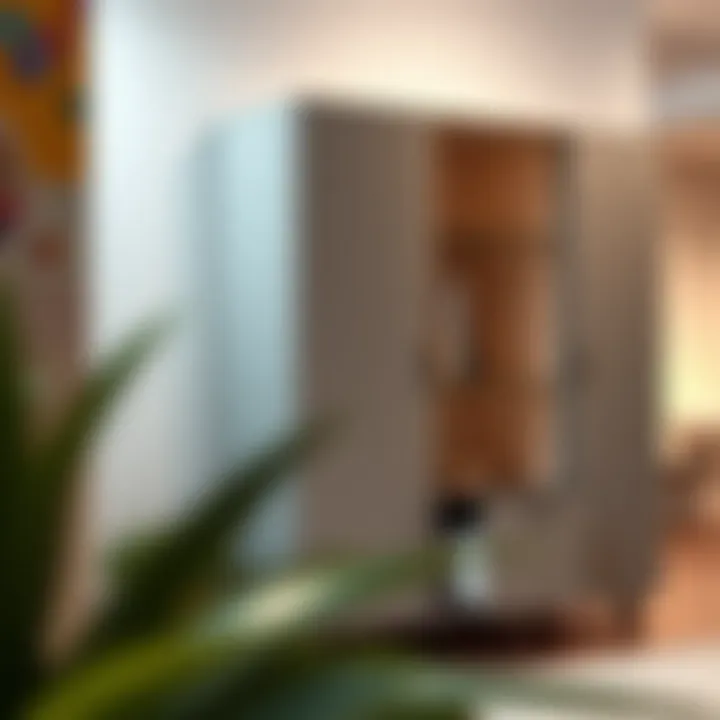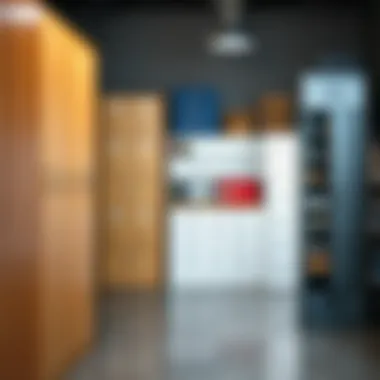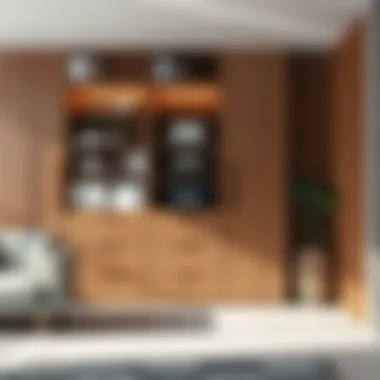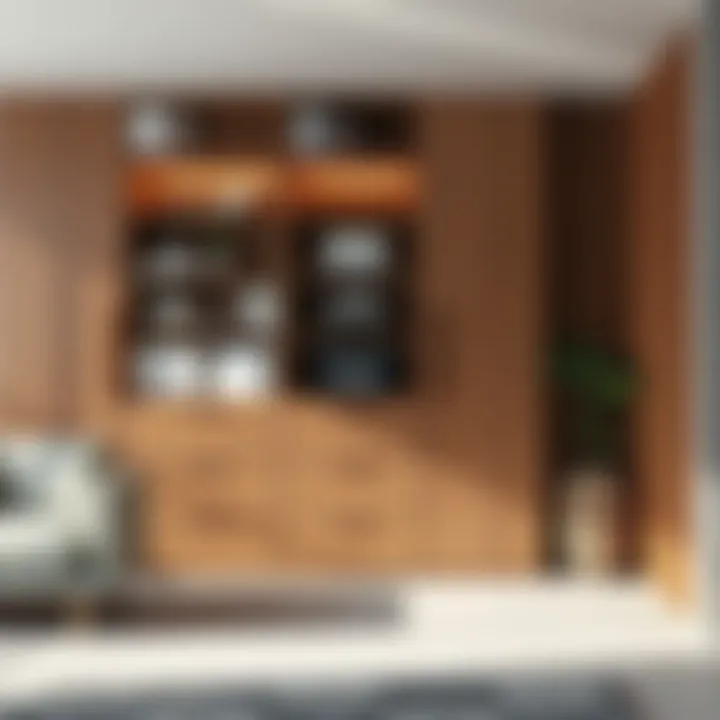File Cabinet Solutions for Organized Storage


Intro
In the fast-paced world we live in, the way we organize our spaces has a significant impact on how we function daily. File cabinets, often overlooked yet vital components of a well-ordered environment, have transformed immensely over the years, reflecting changes in both design preferences and storage needs. At a glance, one might think that a mere metal box suffices, but as this exploration will reveal, today's file storage solutions are thoughtfully designed, marrying form and function in ways that boost both efficiency and style.
Homeowners, interior decorators, and business professionals alike find themselves in an ever-evolving landscape of file cabinet options, and navigating this terrain can feel overwhelming. From compact home office setups to expansive filing systems in busy corporate environments, the increasing significance of organized storage demands our attention. This article aims to illuminate the complexities behind modern file cabinet solutions, providing valuable insights that help you make informed choices.
As we delve into the stylish trends shaping filing systems today, take note of the key characteristics that will not only enhance your space but also align with contemporary aesthetics and functional needs. With a careful eye on innovative materials and sustainable practices, we aim to offer a guide that is both enlightening and practical, ensuring that your quest for storage solutions is well-informed and rewarding.
Understanding File Cabinet Solutions
Deciphering the intricacies of file cabinet solutions is crucial not only for keeping spaces organized but also for enhancing efficiency in both home and professional environments. File cabinets serve as the backbone of organized storage. Recognizing their importance in file organization can save time and reduce stress. Whether you’re a homeowner, a real estate agent, or an interior designer, understanding the various aspects of these storage units can have a huge impact on your workflow and aesthetics alike.
The benefits of file cabinets are multi-faceted. They allow for carefully organized documents that are easily accessible. This ease of access means that when the need arises, you won’t be scrambling through piles of paper. Instead, you can pull out relevant files swiftly—and who doesn’t want that?
In this article, we will delve into the following specific elements:
- The different types of file cabinets available
- The historical evolution of filing systems
- The materials used in construction
- Functional aspects that optimize storage use
- Design trends and aesthetics for home or office
- Technological advancements affecting modern cabinets
When considering file cabinet solutions, important considerations come into play:
- Material durability: Will your cabinet stand the test of time?
- Size and space constraints: Does it fit where you plan to place it?
- Security needs: Do you need locking mechanisms for sensitive documents?
Not every file cabinet is created equal. It’s vital to assess your own requirements. By examining the unique needs of your workspace or home, you can select the most suitable solution.
"Organization isn’t just about the things we see; it’s about creating systems that allow us to engage with our lives more meaningfully."
Having a proper understanding of file cabinets leads to enhanced productivity and a more serene environment. By the time we finish exploring the various aspects of file cabinet solutions, you’ll have composed a knowledgeable sense of how to navigate the landscape of organized storage effectively.
Defining File Cabinets
File cabinets are storage units designed specifically for keeping documents, papers, and sometimes even digital media in an orderly and accessible manner. These cabinets vary greatly in design, functionality, and size, and they often feature multiple drawers to segregate content based on categories. The most common types include vertical, lateral, and mobile file cabinets. Understanding their definitions helps you appreciate their roles in the ecosystem of storage solutions.
At its essence, a file cabinet typically serves two primary purposes: storage and organization. With specific designs aimed at maximizing these functions, file cabinets can cater to almost any storage need—be it for personal records at home or essential documents in a corporate setting.
History of File Cabinets
The concept of file cabinets has evolved dramatically over time. The origins can be traced back to the late 19th century, when they emerged from the need for businesses to manage increasing volumes of paperwork. Early models were often bulky wooden structures with a few drawers, serving a very basic purpose.
As the decades passed, technology and design advancements transformed the file cabinet landscape. The introduction of metal filing cabinets in the mid-20th century marked a significant change, allowing for sturdier and fire-resistant storage solutions.
By the time the digital age dawned, the emergence of electronic records and digital filing systems began to overshadow traditional cabinets. However, the enduring need for organized physical document storage means that file cabinets haven’t been relegated to the past; they continue to adapt. Today, many file cabinets come equipped with features that fuse old-world functionality with modern design aesthetics, catering to contemporary office environments and home offices alike.
The history surrounding file cabinets isn’t just about their physical appearance; it reflects changing business needs and organizational philosophies throughout the ages, making it a topic worth diving into deeper.
Types of File Cabinets
The classification of file cabinets plays a crucial role in understanding storage solutions that best fit individual needs. Each type brings its own unique features, advantages, and applications. Recognizing these differences can greatly assist homeowners, interior designers, decorators, and DIY enthusiasts in their quest for organized storage. Let's delve into the main types of file cabinets and what makes each one stand out.
Vertical File Cabinets
Vertical file cabinets are a staple in both commercial and residential environments. They are built to maximize vertical space, drawing the eye upwards. Typically designed with multiple drawers, these cabinets contribute efficiently to organization while conserving floor space. Their tall and narrow structure makes them ideal for small offices or home environments where room is a premium.
One of the notable benefits of vertical file cabinets is their straightforward design, which allows for easy access and retrieval of files. Each drawer can be tailored to accommodate different file sizes, from letter to legal dimensions. This flexibility can be particularly valuable for individuals who have a mixed assortment of documents to manage.
However, there are considerations to keep in mind. For example, the higher a cabinet, the more difficult it may be to access the top drawers without a step stool, especially for those on the shorter side of the height spectrum. Additionally, some users may find that these cabinets can tip over if not correctly loaded, which could be a concern in homes with children or pets.
Lateral File Cabinets
On the flip side, lateral file cabinets present a different approach. They are wider than vertical versions, offering a flat surface on top that can double as extra workspace. The drawers slide out from the side, making it easier to access contents without needing to reach deep into a cabinet. This can be particularly useful in collaborative work environments where quick access is essential.
Lateral file cabinets accommodate larger volumes of documents and can often hold files side by side, which can help in categorizing and segregating information much better. Their design often makes them more stable, reducing the risk of toppling even when fully loaded. However, they do take up more floor space, so they may not be suitable for smaller rooms.
Mobile File Cabinets
As we continue to explore file cabinet types, mobile file cabinets bring a practical twist to the landscape. Often featuring wheels, these cabinets offer an added element of flexibility. They can easily be moved from one spot to another, which is beneficial in dynamic settings where workspace configurations frequently change.
These cabinets are commonly used in shared office settings but can also be effectively utilized in home offices or craft rooms. The versatility of mobile file cabinets allows for quick access to important documents while maintaining a clean and tidy work area.
One must note, though, that mobility can come at a cost. While many mobile cabinets provide locking mechanisms, ensuring security for stored files remains a necessary consideration. Additionally, their smaller drawer sizes compared to vertical and lateral cabinets might limit the volume capacity for sizable documents or heavy-duty files.
"Different file cabinet types cater to various storage needs, ensuring that whether in home or office, organizing documents can be managed efficiently."
Understanding these types provides the groundwork for selecting the right cabinet. The choice amongst vertical, lateral, and mobile cabinets holds significant influence over not just aesthetics but also functional capacity, impacting everyday efficiency.
Materials Used in File Cabinets
When it comes to choosing the right file cabinet, the materials used play a pivotal role in dictating not just aesthetics but also functionality, durability, and cost. By understanding the various materials employed in file cabinet production, homeowners, interior designers, and even DIY enthusiasts can make well-informed decisions that align with their storage needs and design preferences.
Metal File Cabinets
Metal file cabinets are synonymous with durability and strength. Typically made from steel or other alloys, these cabinets can withstand significant wear and tear. They're an ideal choice for office environments where documents can frequently change hands, or where a high level of security is a priority.
There are several notable benefits to metal file cabinets:
- Security: Many metal cabinets come with locking mechanisms that protect sensitive documents from unauthorized access.
- Fire Resistance: Many metal cabinets are designed to be fireproof, ensuring that critical documents survive unexpected disasters.
- Easy Maintenance: A simple wipe down with a damp cloth is usually enough to keep them looking new.
However, metal file cabinets can be heavier than their wooden or plastic counterparts. They also may lack the warmth and charm that wood provides. Therefore, while they are sturdy and secure, one should consider the decor of the space before making a selection.
Wood File Cabinets
Wood file cabinets bring a touch of elegance and warmth to any room, making them highly sought after for home offices and professional settings alike. The variety of wooden finishes available allows for blending with existing decor seamlessly. Common woods utilized include oak, mahogany, and cherry, each offering its distinct character.
Several aspects make wood file cabinets compelling:
- Aesthetic Appeal: They're often more visually appealing than metal or plastic, lending a sophisticated look to any office space.
- Customization: Wooden cabinets can be stained or painted to match the specific color schemes of a room.
- Longevity: Quality wooden cabinets can last for generations if properly maintained, elevating them as both a storage solution and a piece of heritage furniture.


On the flip side, wood file cabinets can be pricier than other options and might require more upkeep, such as polishing to maintain the finish and addressing any scratches that occur.
Plastic File Cabinets
Plastic file cabinets offer a budget-friendly and lightweight alternative to metal or wooden options. Typically made from high-density polyethylene or polypropylene, they are mold-resistant and capable of withstanding various environmental conditions.
Some advantages of plastic file cabinets include:
- Affordability: They often come at a lower price point, making them accessible for both home users and small offices on a tight budget.
- Weight: Being lighter, they are easier to move and rearrange as needed.
- Versatility: Available in an array of colors and styles, these cabinets can fit into virtually any Home decor.
However, consider that plastic may not have the same durability as metal or wood. It might not be the best choice for long-term storage of valuable items but can serve well in less demanding applications.
"The choice of material can profoundly impact not only the functionality but also the overall feel of your workspace."
Ending
In summary, when selecting file cabinets, it’s essential to weigh the benefits and limitations of each material. Metal cabinets exude strength and security, wood cabinets offer elegance and charm, while plastic cabinets provide affordability and flexibility. The right choice depends on your specific storage needs, aesthetic preferences, and budget. By understanding the materials, one can enhance both utility and style in any filing solution.
Design and Aesthetics
In the realm of organized storage solutions, the concept of design and aesthetics plays an undeniable role. File cabinets have long been utilitarian pieces—essentially, metal boxes with drawers destined for classification tasks. However, as workspaces evolve and home offices sprout like daisies after a spring rain, these cabinets are taking on new significance. They no longer hide in the dark corners of a room; instead, they stand proud as part of the interior décor. Thus, striking a balance between functionality and style has become key.
The importance of design comes down to several factors. It reflects the identity of an environment, showcasing the taste and professionalism of an individual or business. A well-designed file cabinet has the potential to enhance productivity, providing an organized space that promotes smooth operations. When your surroundings are visually appealing, it can foster creativity and completely enhance focus.
Modern Design Trends
Today, file cabinets are breaking the mold of their older counterparts, embracing modern aesthetics. Minimalism is a prevailing theme, reducing clutter and emphasizing clean lines. Think of straight, sleek cabinets that feel light yet sturdy. Designs such as the Scandinavian influence also take the limelight, favoring light colors and natural wood textures.
On the flip side, industrial-style cabinets with metal finishes, exposed hardware, and recycled elements cater to those who value grit over gloss. Innovatively designed cabinets therefore serve not just as storage, but also as art pieces that evoke interest. For example:
- Floating cabinets that resemble bookshelves—ideal for smaller spaces.
- Mixed media designs combining wood and steel make a statement without sacrificing durability.
Color and Finish Options
When it comes to color and finish, the choices can seem infinite, yet they boil down to the intended atmosphere you want to create. Subtle hues like soft grays and whites give a calm, professional vibe while vibrant colors like royal blue or bold red can energize a space.
Reflective surfaces, like high gloss finishes, add a modern touch, while matte finishes offer a more understated elegance. The right color palette can serve to:
- Introduce harmony with existing decor.
- Create a focal point in the room.
- Influence the mood of the space.
In addition to standard colors, custom finishes allow homeowners to match their cabinets precisely to specific wall tones or furniture. This ensures that the file cabinet does not just merge into the environment, but rather complements it beautifully, blending function with flair.
Customization Possibilities
Customization takes the idea of aesthetics a step further. Homeowners can now tailor their file cabinets to suit their personal preferences, needs, and spatial constraints. Options abound—drawers can be made deeper or shallower, while compartments can be added for specialized items like documents, electronic devices, or supplies.
Adventurous homeowners might even opt for unique hardware choices, from handles to locks, further enhancing individual design. This tailored approach encourages:
- A stronger personal connection to the furniture.
- Improved organization through personalized layouts.
- Greater versatility to adapt to changing needs over time.
Such customization principles are not new, dating back to historical milestones in furniture design; however, technology has now made it easier to materialize these desires. Companies get creative, utilizing online visualization tools that let customers see their custom designs before committing.
"The beauty of file cabinets is that they do not have to be mere functional necessities. Considering design and aesthetics transforms them into essential elements of a well-balanced space."
Functional Aspects of File Cabinets
When it comes to choosing a file cabinet, functionality reigns supreme. The right file cabinet isn’t just a pretty face; it serves as the backbone of any organized storage solution. In this section, we delve into the essential components of functionality that make file cabinets indispensable in both home and office settings. The facets of drawer organization, locking mechanisms, and space-saving designs play crucial roles in enhancing usability and ensuring that these storage units meet your specific needs. A balance between form and function can make a significant difference in everyday operations.
Drawer Organization
Efficient drawer organization is akin to having a well-oiled machine. When drawers are organized correctly, locating documents becomes a breeze. Imagine standing in front of a disheveled drawer with papers strewn about. It's enough to drive you up the wall! On the contrary, thoughtfully arranged compartments can reduce stress and save time.
Here are some practical tips for drawer organization:
- Use Dividers: Drawer dividers help separate files, minimizing clutter and ensuring that each item has its place. You can buy adjustable dividers to customize based on your drawer's size and your filing system.
- Labeling: Clear labels on folders or sections in a drawer facilitate swift document retrieval. This is especially vital in an office setting where time is money.
- Categorization: Group related documents together. For example, keep invoices, proposals, and contracts in separate sections. This categorized layout reduces frustration when searching for important papers.
A well-organized drawer not only boosts efficiency but also reflects professionalism, which is crucial in work environments.
Locking Mechanisms
With the rising concerns about security and data breaches, the role of locking mechanisms in file cabinets has never been more crucial. The presence of a locking mechanism serves as a deterrent against unauthorized access to sensitive documents. Various options are available, each with its own merits:
- Key Locks: Simple and straightforward, traditional key locks offer basic security. They are reliable, but can be a hassle to manage multiple keys.
- Combination Locks: These provide a higher level of security as you don’t need to worry about losing a key. However, forgetting the code can lead to frustration.
- Electronic Locks: The modern twist, electronic locks offer convenience and can even include biometric options. For the tech-savvy, this may be the way to go, as it allows for quick access and enhanced security features.
Implementing effective locking mechanisms is essential, especially for businesses handling confidential data. This small investment in security can save headaches and potential financial losses later on.
Space-Saving Solutions
In today's fast-paced world, space is often at a premium. File cabinets that embrace space-saving designs are a game-changer. They not only serve their functional purpose but also adapt to various layouts, making them ideal for small offices or home workspaces. Consider the following strategies:
- Vertical Designs: Tall and narrow cabinets make use of vertical space, keeping the floor area clear. This can be beneficial in cramped rooms where every inch counts.
- Mobile File Cabinets: Options on wheels let you reposition storage as needed. This flexibility is perfect for multipurpose spaces where the layout changes frequently.
- Hidden Storage: Some cabinets double as furniture, serving as side tables or even decorative pieces. This clever design merges functionality with aesthetics, allowing homeowners to integrate storage naturally into their decor.
Not only do space-saving solutions provide practical benefits, but they also contribute to a clean and organized look, promoting productivity and creativity in your working environment.
"An organized workspace is not merely about aesthetics, but a pathway to enhanced productivity and peace of mind."
By keeping functional aspects like drawer organization, robust locking mechanisms, and effective space-saving solutions in mind, you can make informed choices when selecting file cabinets that suit your needs. Not only will these choices impact your immediate space but they can also enhance long-term efficiency and security. Ultimately, these functionalities form the cornerstone of a well-organized filing system.
File Cabinets in the Workplace
When it comes to the workplace, the role of file cabinets is often underestimated. Many view them simply as a means to stow away paperwork, but their purpose extends far beyond just storage. File cabinets contribute to maintaining an organized environment, boosting efficiency, and establishing a professional appearance that can inspire confidence among clients and stakeholders. The right cabinet can create an atmosphere that fosters productivity.
Optimizing Office Layout
In the context of office design, the placement and choice of file cabinets can make a world of difference. By incorporating them into the layout effectively, you can achieve an organized workspace that minimizes distractions and maximizes accessibility. Here are some key points:
- Strategic Placement: Position file cabinets near frequently used workstations to ensure ease of access. No one likes to waste time searching for files when they could be diving into their tasks.
- Flow of Movement: Consider how employees move through the space. File cabinets should not obstruct pathways but should enhance the ability to navigate the office smoothly.
- Utilizing Vertical Space: Many offices might be short on real estate. Vertical file cabinets can reach up instead of out, which is especially useful in smaller spaces.
- Anecdotal Tip: For a lively touch, choose cabinets in varying heights to create visual interest while also breaking the monotony of a flat office layout.


Forging a balance between accessibility and aesthetic can provide a welcoming yet professional vibe. After all, presence matters, and the right file organization can cultivate a sense of order and purpose in the everyday hustle.
Compliance and Security
Another critical aspect of file cabinets in the workplace revolves around compliance and security. With sensitive information flowing through most businesses—from private employee records to crucial client data—having the right cabinet goes beyond mere organization. Here’s why they are essential:
- Locking Mechanisms: Many file cabinets come with built-in lock systems, ensuring sensitive documents remain secure and are only available to authorized personnel.
- Regulations Adherence: Different industries adhere to various regulations regarding document handling. For example, healthcare providers must comply with HIPAA regulations that emphasize confidentiality. Choosing cabinets that support these requirements can help mitigate risks associated with data breaches.
- Organized Record Keeping: Implementing a systematic filing system within the cabinets allows for easier audits and inspections. Think about how much easier it is to retrieve files when everything is categorized and clearly labeled.
"A stitch in time saves nine." If one pays attention to proper filing now, it can save a lot of headaches later during compliance checks or security audits.
In summary, file cabinets are not just furniture; they play a vital role in shaping workplace efficiency and safety. By considering their placement in office design and recognizing their importance in compliance, businesses can harness the full potential of these storage solutions. Investing in the right file cabinets can bring order to chaos and create a solid foundation for an organized workspace.
Home Office File Cabinet Solutions
Creating an organized workspace at home is paramount in today’s remote working environment. This section sheds light on the significance of file cabinets specifically tailored for home offices. The intersection of functionality and aesthetics plays a crucial role in ensuring that the home office not only promotes productivity but also reflects personal style.
One of the central elements to consider when choosing file cabinets is how they complement the overall home decor. A cabinet that clashes with the surrounding environment can disrupt the flow of design within the space. For instance, a sleek metal file cabinet might not blend well in a cozy, traditional study. Here, opting for a wooden cabinet might enhance the warm, inviting feeling of the room while still providing necessary storage. Therefore, the balance between function and style becomes a critical factor in maintaining a harmonious home office.
Moreover, the benefits of having a dedicated file cabinet extend well beyond aesthetics. A well-organized cabinet facilitates easy access to important documents, thereby minimizing clutter and enhancing efficiency. Not having to rummage through piles of papers can save precious time and reduce stress.
Balancing Function and Style
Achieving a balance between functionality and style in home office file cabinets can feel like walking a tightrope. Homeowners often desire cabinets that not only serve a practical purpose but also add an element of sophistication to their work environment.
Selecting cabinets with features like adjustable shelves or multipurpose drawers can enhance functionality. These design elements allow you to adapt the storage solution based on changing needs, whether it’s filing papers, storing books, or housing office supplies. Additionally, the choice of colors and finishes plays an equally pivotal role. A calming color can promote concentration, while a bold hue might showcase personal flair.
It's important to remember that a cabinet should also offer ease of use. One key consideration is the placement of handles or knobs. Handles that are too small or awkwardly positioned can quickly become a source of frustration. Instead, go for ergonomic designs that combine aesthetic appeal with practicality.
"A well-placed file cabinet can turn the chaos of home work into a symphony of order."
Remote Work Considerations
As more people embrace remote work, the need for an efficient filing system becomes increasingly imperative. A well-designed file cabinet can dramatically impact productivity and work-life balance.
One of the primary considerations is selecting a cabinet that fits within your available space without overwhelming it. It can be tempting to choose larger, more visually appealing cabinets, but practicality often trumps grandeur in a confined home office. Compact models associated with vertical and mobile options may offer versatile solutions, making it easier to reposition them whenever necessary.
Also, think about security features. With sensitive documents being stored at home, securing them becomes a priority. Locking mechanisms can provide peace of mind, ensuring that confidential information remains under wraps. Many modern cabinets come equipped with locks that blend seamlessly with their design, leaving the aesthetics intact while offering essential security.
Finally, while functionality is undoubtedly essential, don’t overlook how the cabinet motivates you. An appealing design can inspire a more productive mindset, turning your home office into a space where you actually enjoy spending time. The right piece can uplift the ambiance, making those long hours of work a bit more pleasant.
By carefully considering these aspects, homeowners can make informed decisions about file cabinets that not only serve their storage needs but also enhance their home office experience. In this way, selecting the right file cabinet can pave the way for a more organized, motivating, and enjoyable remote work environment.
Sustainable Practices in File Cabinet Production
As the world increasingly acknowledges the importance of sustainability, the file cabinet industry is no exception. The rise of environmentally-friendly practices in production not only meets consumer demand but also significantly contributes to reducing the ecological footprint. This section will explore the use of recycled materials and eco-friendly manufacturing processes, emphasizing how these practices improve the overall appeal and functionality of file cabinets.
Recycled Materials
When considering file cabinets, the use of recycled materials is a game changer. Manufacturers are turning to substances like recycled metal, plastic, and wood to create cabinets that are both functional and sustainable. This is important, especially as materials like steel and aluminum, when recycled, can save up to 95% of the energy required to produce them from scratch. Moreover, this approach lessens the depletion of natural resources, which has become a pressing concern in today's world.
Benefits of using recycled materials include:
- Reduced Waste: Helps divert materials from landfills.
- Conservation of Resources: Less reliance on virgin materials saves forests and reduces mining activities.
- Lower Carbon Footprint: Producing items from recycled materials typically requires less energy, leading to fewer greenhouse gas emissions.
For instance, consider a modern file cabinet made from recycled aluminum. Not only does it boast durability and resilience, but it also tells a story of environmental responsibility. Homeowners and businesses looking to furnish their spaces can feel proud knowing they contribute to a sustainable future.
Eco-Friendly Manufacturing Processes
Beyond the materials themselves, the manufacturing processes employed in file cabinet production are crucial in fostering sustainability. Many leading manufacturers are adopting eco-friendly practices that minimize waste, energy use, and harmful emissions. This includes:
- Water-Based Finishes: Using non-toxic finishes reduces harmful chemical exposure.
- Energy-Efficient Production: Factories are increasingly utilizing renewable energy sources, making production cleaner.
- Lean Manufacturing Techniques: These practices aim at minimizing waste through efficient resource management and streamlined production processes, thus creating less environmental strain.
"Sustainable manufacturing is not just a trend; it's the future, and it's crucial for maintaining a healthy planet."
The integration of eco-friendly processes not only cultivates responsible production habits but also appeals to modern consumers who prioritize environmental stewardship. As a result, file cabinets produced through these methods often command a greater respect in the marketplace, appealing to homeowners and businesses hoping to align with greener practices. Ultimately, this conscious move towards sustainability allows everyone to choose storage solutions that not only look good but also help sustain the planet.
In this rapidly evolving landscape, integrating sustainable practices solidifies the role of file cabinets as not just storage solutions but active participants in the effort to preserve our environment. Consumers are encouraged to consider these practices when making purchases, as every little bit counts in the grand tapestry of ecological responsibility.
Technological Integration in File Cabinets
The landscape of organized storage has undergone a significant metamorphosis in recent years, primarily driven by advancements in technology. This section explores the critical role that technological integration plays in modern file cabinets, from enhancing usability to promoting efficient organization. The relationship between functionality and technology is intricate, but as we'll see, these innovations are not merely about adding features; they are about fundamentally transforming how we think of file storage.
Digital File Management Solutions
In an era where data is increasingly digital, the need for effective file management solutions cannot be overstated. Digital file management solutions enable users to scan, organize, and retrieve documents in a way that minimizes physical clutter while maximizing accessibility.
- Cloud Storage: Applications like Google Drive or Dropbox allow individuals to upload scanned documents directly to the cloud. By integrating file cabinets with these tools, homeowners can access files from anywhere, providing a sense of flexibility that traditional cabinets simply can’t facilitate.
- Document Management Software: Programs such as DocuWare revolutionize how files are tracked and managed. Users can label documents with keywords, making searches instantaneous. Integrating such systems directly with physical cabinets can streamline workflows, allowing for straightforward links between digital and physical records.
These digital solutions are not just practical; they also promote sustainability. By reducing the need for paper, homeowners and businesses can save costs while also contributing to environmental efforts.
Smart File Cabinets
Smart file cabinets take technological innovation a notch higher. These cabinets offer features that go beyond conventional filing systems by incorporating various forms of technology that enhance their usability and security.
Some notable features include:
- Bluetooth and Wi-Fi Connectivity: Imagine a file cabinet that integrates with your home automation system. With Bluetooth or Wi-Fi, users can lock or unlock drawers from their smartphones, a handy feature for security-conscious homeowners.
- Integrated Tracking Systems: Certain smart cabinets come equipped with tracking technologies that can sense whether files are being accessed, who accessed them, and when. This adds an extra layer of security and can be particularly beneficial in offices where sensitive documents are stored.
- Built-in Document Readers: With advancements in reading technologies, some smart cabinets can scan and recognize document types automatically, categorizing them effectively. This can reduce human error and help maintain better organization within drawers.
Technological integration in file cabinets allows users to mesh the digital world with the physical, resulting in a storage solution that emphasizes efficiency and ease of use. Investing in such smart systems means not just keeping up with trends but rather preparing for the future of organized storage.
"Technology is not just a tool; it is a way to redefine our spaces and our processes for the better."
As homeowners, interior designers, and real estate professionals consider their options for organized storage, the emphasis on technological integration should not be overlooked. It offers a spectrum of benefits that enhance both functionality and aesthetics, leading to a more cohesive living and working environment.
Cost Considerations


Understanding the costs involved in selecting file cabinets is crucial for any individual or business making storage decisions. The financial implications often steer choices, affecting everything from the materials to the overall functionality of the cabinets. By factoring in cost considerations, buyers can strike a balance between affordability and quality, ensuring that their investment serves its purpose without breaking the bank. This section will break down budget-friendly options and the importance of investing in quality.
Budget-Friendly Options
When it comes to finding economical file cabinet solutions, potential buyers should first look at various budget-friendly options available on the market today.
- Material Choice: Metal cabinets are usually the most cost-effective choice. They are durable and often require less maintenance than wood or plastic counterparts.
- Buying Used: Consider purchasing second-hand cabinets. Many businesses sell their old office furniture at a fraction of the cost, providing good quality options at a lower price. Also, thrift shops or online marketplaces often have gems at surprising prices.
- No Frills: Sometimes, simple designs without fancy features can save a lump sum. A straightforward file cabinet without a locking mechanism or extra drawers can still fulfill basic storage needs at a lower cost.
While it’s tempting to grab the cheapest option on the shelf, buyers should keep in mind the long-term value. A seemingly inexpensive cabinet might need replacement sooner due to wear and tear, leading to additional costs down the line.
Investing in Quality
Investing in high-quality file cabinets pays off over time. Here’s why a little extra spent now can save a lot later.
- Longevity: Quality file cabinets, especially those made from solid wood or robust metals, typically last for many years. Unlike cheaper counterparts that may buckle under the weight of files, a good filing system maintains its integrity, ensuring that documents remain safe and organized.
- Enhanced Functionality: Higher-end cabinets often come with improved organizational features, such as adjustable shelves and sturdier drawer mechanisms, which enhance usability and make accessing documents easier.
- Aesthetic Appeal: While function is crucial, the design shouldn't be an afterthought. Investing in quality furniture enhances the overall appearance of your office or home workspace. You can choose a style that fits seamlessly with your decor, elevating your space's design and making it feel more professional.
"Buying cheap often proves expensive in the long run." - A timeless adage that holds true for filing systems as well.
Choosing the Right File Cabinet
Choosing the right file cabinet is not just a matter of aesthetics or even simple functionality; it’s about understanding your unique storage needs and how a file cabinet fits into your overall organization and efficiency strategy. The importance of making an informed choice here cannot be overstated. After all, a well-chosen file cabinet serves as the backbone of any organized workspace, whether it’s in a bustling office or a cozy home office.
Assessing Your Needs
To start, assessing your needs is the first step toward selecting the appropriate file cabinet. Think about what items you need to store. Are they documents, supplies, or digital files that you're transitioning? Each of these might require a different type of cabinet or organization method.
- Document Volume: If you have reams of paperwork piling up, a larger vertical or lateral cabinet might be necessary.
- Accessibility: Consider how often you will need to access these files. A mobile cabinet might suit the needs of someone who moves around frequently.
- Space Constraints: Evaluate the physical space available. It may seem tempting to select something grandiose, but if your room is tight, that can quickly turn into a cumbersome mistake.
"A file cabinet should bring style and order, not chaos and frustration."
With all of these factors in mind, it’s crucial to take an inventory of both your requirements and your available space before diving into the selection process.
Comparing Options
Once your needs are assessed, comparing your options is the next logical step. The market offers a wild variety of choices. Here are some considerations to keep in mind when sifting through the myriad of available products:
- Type of Cabinet: As discussed earlier, options include vertical, lateral, and mobile cabinets, each with its own pros and cons.
- Material: This goes back to aesthetics and durability. Metal cabinets tend to offer longevity and security, especially for sensitive documents. Wooden options might provide a more elegant look that suits a classic or high-end home office design. Plastic cabinets can be lightweight and cost-effective but might lack the sturdiness that heavier materials provide.
- Enhancements: Look for additional features that can ease your daily organizational tasks. Locking mechanisms, adjustable shelves, and built-in dividers can make a substantial impact on your overall file management process.
- Cost vs. Value: While it’s tempting to go for the cheapest available option, weigh the overall value. Investing a bit more in a quality cabinet often pays off in durability and longevity, preventing you from having to replace it within a year or two.
- Vertical cabinets tend to fit neatly in corners or against walls, whereas lateral cabinets provide easier access to files in shared spaces.
- Mobile cabinets can be especially beneficial for collaborative environments where team members frequently share documents.
As you navigate this window-shopping phase, don’t hesitate to ask for input from others who may have firsthand experience with different cabinets. Opinions that come from practical usage can shine a light on features that may or may not be essential to your own needs.
By thoughtfully assessing your needs and comparing options, you set the stage for making a savvy purchase that enhances your storage solutions, rather than hinder them.
Maintenance and Care for File Cabinets
When it comes to file cabinets, a little attention goes a long way. Maintenance and care are crucial, not just for preserving the appearance of your cabinets, but also for extending their lifespan. A well-maintained file cabinet not only looks better but also functions more effectively. The way you treat your file cabinets can impact their efficiency, accessibility, and overall value, making it an important aspect to consider.
Cleaning and Upkeep
Cleaning a file cabinet might sound mundane, but it’s essential. Regular cleaning can prevent dirt and dust build-up, which can affect the drawers’ mobility and even the integrity of the material over time. Here are some simple yet effective tips for maintaining cleanliness:
- Dust Regularly: Use a soft cloth or microfiber duster to remove dust from surfaces. This should be done at least once a month to keep things tidy.
- Use Appropriate Cleaners: Depending on the material—whether it's metal, wood, or plastic—choose a cleaner that won't damage the finish. For metal cabinets, a damp cloth with mild detergent works wonders, while wood cabinets might require furniture polish to maintain their shine.
- Check for Spills: Accidental spills can lead to marks or, worse, long-term damage. Handle them quickly by dabbing with a clean, dry cloth to absorb any liquid.
- Inspect Hardware: Periodically examine handles, locks, and slides for any signs of wear or loose screws. Tightening them can prevent further damage down the line.
By instituting these cleaning habits, you help ensure that your cabinets not only remain visually appealing but also continue to offer smooth functionality.
Repairs and Restoration
No matter how well you maintain them, wear and tear on file cabinets is inevitable over time. Understanding how to assess and handle repairs keeps your cabinets in top shape. Here are some common issues and solutions that might pop up:
- Dented or Scratched Surfaces: Minor dents and scratches can often be remedied easily. For metal surfaces, try using a metal polish or scratch repair kit to blend in imperfections. On wooden cabinets, a wood filler or touch-up pen can help minimize the appearance of scratches.
- Sticking Drawers: If your drawers are sticking or hard to open, it might be a sign that they are misaligned or need lubrication. Apply a dry lubricant to the runners, which can drastically improve drawer movement.
- Locking Mechanism Troubles: If you find that the locks aren't working as they should, it could be a simple fix. Ensure no debris is clogging the mechanism or, if necessary, replace the lock entirely.
- Replacing Hardware: If handles or knobs are broken, consider replacing them with something new. Not only does this fix the problem, but it can also give your cabinet a fresh look.
Taking the time to carry out repairs when needed can prevent larger, costlier issues down the road. Just like any piece of furniture, a little bit of TLC can breathe new life into a file cabinet.
"Caring for your file cabinet is like investing in the longevity of your organization. The more you put in, the more you get out."
Future Trends in File Cabinets
The evolution of file cabinets is much more than meets the eye. As we delve into the future trends in file cabinet design, one can’t help but notice how these storage solutions are adapting to the changing needs of both households and businesses alike. Currently, there’s a significant shift in user expectations towards functionality, sustainability, and technological integration. Understanding these shifts is key for anyone considering an investment in a file cabinet. This section will discuss the emerging trends in terms of user needs and innovations that promise to shape the landscape of organized storage.
Evolving User Needs
In today’s world, where flexibility and adaptability are paramount, it's no surprise that user needs are constantly evolving. People require storage solutions that not only save space but can also blend seamlessly into their environments. Many homeowners and professionals are living in smaller spaces, driving demand for compact yet highly functional file cabinets.
- Multi-Functionality: Users are increasingly looking for cabinets that can do more than just hold files. This means integrating compartments for office supplies, or even shelves for books, transforming file cabinets into versatile pieces of furniture.
- Ergonomics and Ease of Use: With the rise of remote work, comfort becomes vital. Users now favor cabinets that are easy to access and ergonomically designed to minimize strain during use.
- Aesthetic Considerations: The traditional, utilitarian appearance of file cabinets is giving way to more chic designs. Homeowners are gravitating toward cabinets that enhance interior aesthetics, opting for richer colors and smoother finishes.
Innovations on the Horizon
As the future unfolds, innovative design and technology are taking center stage in the world of file cabinets. With the rise of smart technology, one can expect significant changes:
- Smart Cabinets: Imagine a cabinet that integrates with your digital filing system. Smart file cabinets might feature built-in technology for scanning and digital archiving, serving as a bridge between physical and digital files, minimizing the clutter of paper documents.
- Sustainable Materials: With environmental concerns building, a shift towards greener materials in cabinet construction is in the works. File cabinets made from recycled materials and sustainable wood are becoming more common, appealing to the eco-conscious consumer.
- Advanced Locking Mechanisms: Security remains a top priority for many users. As we look ahead, we may see more advanced locking mechanisms such as biometric entries, linking directly to the concept of smart cabinets. This enhances the security of sensitive documents stored within.
The shift towards smarter, more environmentally friendly designs in file cabinets reflects broader trends in consumer preferences, emphasizing the need for adaptability and sustainability.
Final Thoughts
In concluding this exploration of file cabinet solutions, it's clear that choosing the right storage option is more than just picking a drawer with some slots. It’s an essential decision that influences organization, efficiency, and even aesthetics in both home and workplace settings. As we distill the insights gathered from our discussion, some critical elements stand out.
Synthesizing Insights
With the relentless pace of modern life, having an orderly filing system becomes paramount. We've discussed various types of file cabinets, their materials, and design trends that cater to different organizational needs. Think about how vertical cabinets fit snugly into tight spaces, while lateral models offer expansive storage in wider areas. Not to forget the mobile cabinets, providing versatility when you need to shift documents quickly.
Among these options, the choice signifies a balance between functionality and appeal. Durable materials favor long-term investment, but a beautiful exterior enhances the ambiance of any room. The integration of technology into modern cabinets, such as smart features, has become increasingly relevant as the digital age progresses. Keeping files accessible, yet secure, is a priority, and recognizing the importance of sustainable practices in production can significantly influence the choice in purchasing.
Encouraging Thoughtful Selection
As you're on the journey to select a file cabinet, pausing to reflect on a few considerations can save you from future headaches. First, assess your storage needs—how many documents do you realistically have and anticipate? This assessment helps in understanding the necessary size and type. It’s also wise to think about whether you need a stylish piece or simply something functional.
Consider also the long-term implications. Investing in quality often saves money over time, as it reduces the need for frequent replacements. Be sure to explore customization options that align with your workspace's aesthetic. And let’s not forget about the ecological aspect; opting for cabinets made from recycled materials can contribute to a healthier planet.
"The right file cabinet isn't just a storage unit; it's an investment in the organization and efficiency you want to achieve."
In essence, thoughtful selection of the filing system is key to creating a harmonious and functional environment, whether at home or the office.















